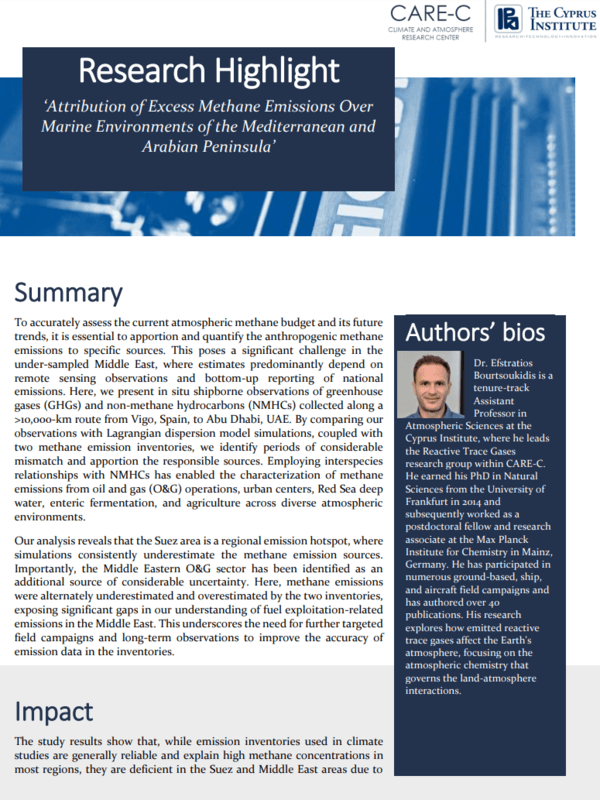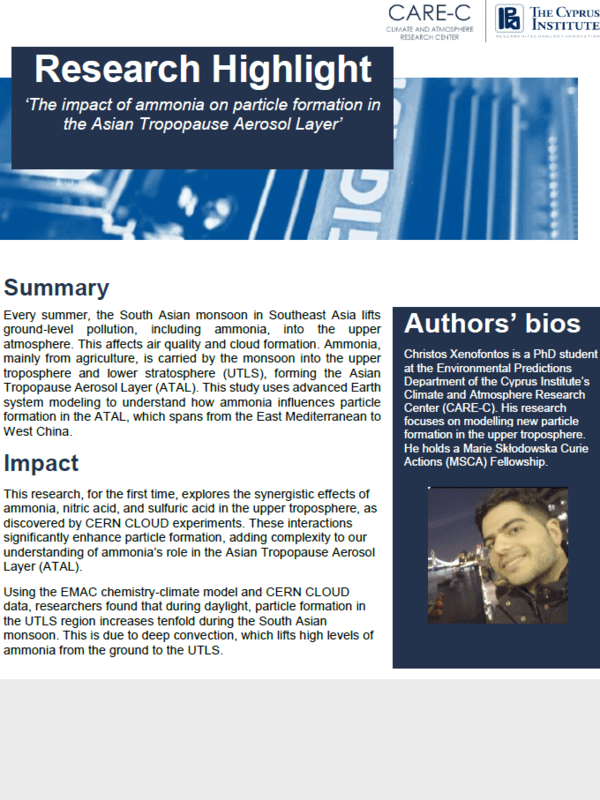Past Research Highlights

Global high-resolution ultrafine particle number concentrations through data fusion with machine learning
Global high-resolution ultrafine particle number concentrations through data fusion with machine learning presents the first global maps of particle number concentration (PNC) and associated ultrafine particles (UFPs) at 1 km resolution over land for 2010–2019, led by the Climate and Atmosphere Research Center (CARE-C) of The Cyprus Institute in close collaboration with the Computation-based Science and Technology Research Center (CaSToRC) of The Cyprus Institute and the Max Planck Institute for Chemistry (MPIC). The study fuses long-term measurements from 155 ground stations with a rich set of global predictors, including emissions, NO₂ and PM₂.₅ fields, population and built-up volume, road networks, and key meteorological variables, using an XGBoost regression model with conformal prediction for uncertainty quantification. The model attains R2≈0.90 on an independent test set and R2 of 0.77–0.87 under spatial and temporal cross‑validation, and indicates that UFPs constitute on average about 91% of total PNC, with annual mean near-surface PNC ranging from a few thousand cm⁻³ in pristine regions to over 40,000 cm⁻³ in polluted urban centres. The resulting open-access NetCDF dataset (2010–2019) provides annual mean PNC, UFP and 95% coverage intervals on a global 1 km grid, enabling direct integration with high‑resolution population data for exposure and health impact studies.

Global impact of anthropogenic NH3 emissions on upper tropospheric aerosol formation
Atmospheric ammonia can double the number of atmospheric particles over high emission regions and lead to the potential for increased cloud formation, a study finds. Anthropogenic ammonia emissions, which primarily stem from agricultural activities such as fertilizer application, are projected to double by 2100. While much is known about ammonia’s effects on surface air quality, less is known about how much reaches the upper atmosphere and its effects there. Christos Xenofontos and colleagues modeled the effect of anthropogenic ammonia emissions on particle formation in the upper troposphere and lower stratosphere. The authors compared two global simulations of atmospheric chemistry, one with anthropogenic ammonia emissions included and a baseline with no human-caused emissions. The model shows that convection carries ammonia above the surface layer, strongly enhancing aerosol formation and growth, resulting in changes in aerosol composition and abundance over high emission regions. These aerosol particles increase cloud condensation nuclei by 2.5 times compared to baseline. Aerosol optical depth increased by 80% which affects the absorption of light by particles in the atmosphere and potentially climate. According to the authors, ammonia is projected to reach the upper troposphere in high enough concentrations that its effects should be included in climate models and projections.

Environmental Change Is Reshaping the Temperature Sensitivity of Sesquiterpene Emissions and Their Atmospheric Impacts
Air temperature plays a crucial role in regulating ecosystem functions, particularly the release of biogenic volatile organic compounds (BVOCs) that drive biosphere–atmosphere interactions. Among these, sesquiterpenes (SQTs) are especially important due to their dual role as ecologically significant compounds and highly reactive atmospheric constituents. Although the relationship between temperature and biogenic emissions is complex, global emission estimates often rely on oversimplified models that assume a uniform exponential response across ecosystems and conditions. To address this, we synthesize two decades (1997–2019) of SQT emission studies, revealing substantial variability in both temperature responses and basal emission rates, largely influenced by plant functional types (PFTs) and environmental cofactors. Incorporating PFT-dependent parameterizations into emission-chemistry simulations demonstrates sensitive feedbacks on atmospheric processes, including ground-level ozone (O₃) production and secondary organic aerosol (SOA) formation. Notably, we find a statistically significant decline in SQT temperature responses over time, suggesting that environmental changes are reshaping the fundamental link between temperature and SQT emissions. This meta-analysis identifies the temperature sensitivity of sesquiterpenes (βSQT) as a critical parameter at the interface of the biosphere, environmental change, and atmospheric processes, with far-reaching effects on air quality and climate. Ultimately, our findings highlight the potential of βSQT to serve as a “volatile stressometer” for ecosystem–atmosphere interactions, where environmental stresses modulate emission responses with cascading consequences for atmospheric chemistry and climate-vegetation feedbacks.

Identification of New Particle FormationEvents Using a You Only Look Once (YOLO) Deep Learning Algorithm
A new study published in the ACS ES&T Air special issue “Elevating Atmospheric Chemistry Measurements and Modeling with Artificial Intelligence” introduces, for the first time, a deep learning method—the You Only Look Once (YOLO) algorithm—to detect atmospheric new particle formation (NPF) events. NPF events involve the formation and growth of molecular clusters, which is a key process that influences air quality, climate, and human health. The study is led by Rajat Bhandari, under the supervision of Dr. Vijay P. Kanawade (CARE-C, CyI) and Assoc. Prof. Chandan Sarangi (Indian Institute of Technology Madras, India), with support from a global team of collaborators, including colleagues from CyI (Dr. Michael Pikridas, Prof. Jean Sciare, and Assoc. Prof. Tuija Jokinen).

Temperature extremes and human health in Cyprus: Investigating the Impact of Heat and Coldwaves
Extreme temperatures are an emerging public health concern in the Mediterranean, yet their full impact remains underexplored. Our study investigates the public health impacts of both heat and cold extremes in Cyprus, a Mediterranean country increasingly affected by climate variability.
While heatwaves during summer months are becoming more frequent and better studied, cold spells—though less common—continue to pose significant and often overlooked health risks. Using high resolution climate data alongside national mortality and hospitalization records from 2004 to 2019, we applied advanced statistical models—including Distributed Lag Non-Linear Models (DLNMs) and Generalized Additive Models (GAMs) — to quantify health risks across seasons. Heatwave and coldwave events were identified through a detailed climatological analysis of long-term temperature data. The health impact analysis captures both the immediate and delayed effects of temperature extremes and evaluates how prolonged heatwaves and coldwaves influence health outcomes. We assessed impacts across major health causes, including cardiovascular, respiratory, diabetes and cancer-related conditions. This is the first study in Cyprus to jointly assess mortality and hospitalizations across a wide range of causes and seasons, offering a comprehensive view of how temperature variability affects population health in a climate-sensitive region.

Effect of planetary boundary layer evolution on new particle formation events over Cyprus
This study investigates how the evolution of the planetary boundary layer (PBL) influences new particle formation (NPF) events over Cyprus, a region impacted by both local and transported atmospheric conditions. Utilizing a combination of long-term ground-based observations and meteorological data, the research study emphasizes the presence of distinct patterns in PBL dynamics that correspond to the timing, intensity, and frequency of NPF events during the year 2022. The study’s key findings indicate that rapid morning PBL growth and vertical mixing processes play a critical role in transporting precursor gases and freshly formed particles, thereby modulating the onset and development of NPF.

AI-powered estimation of tree covered area and number of trees over the Mediterranean island of Cyprus
Trees play a crucial role in mitigating climate change by absorbing CO2 and providing biophysical cooling. In Cyprus, an EU member state located in the Eastern Mediterranean, and a climate change hotspot, increasingly impacted by forest fires and more arid conditions, the absence of a comprehensive tree monitoring system hinders effective carbon stock assessment and land-based mitigation strategies for the achievement of the European Commission goal of substantial greenhouse gas reductions by 2030.
This study presents a deep learning neural network model applied to high resolution (10 cm) airborne images collected during the year 2019, to generate segmented tree crowns and the number of individual trees over selected areas of Cyprus, including a large national forest park, a forest park in the capital city, and a small urban area, encompassing a total studied area of 107 square kilometers.

Atmospheric health burden across the century andthe accelerating impact of temperature comparedto pollution
Anthropogenic emissions alter atmospheric composition and therefore the climate, with implications for air pollution- and climate-related human health. Mortality attributable to air pollution and non-optimal temperature is a major concern, expected to shift under future climate change and socioeconomic scenarios. In this work, results from numerical simulations are used to assess future changes in mortality attributable to long-term exposure to both non-optimal temperature and air pollution simultaneously.

Attribution of Excess Methane Emissions OverMarine Environments of the Mediterranean and Arabian Peninsula
To accurately assess the current atmospheric methane budget and its future trends, it is essential to apportion and quantify the anthropogenic methane emissions to specific sources. This poses a significant challenge in the under-sampled Middle East, where estimates predominantly depend on remote sensing observations and bottom-up reporting of national emissions.
Here, we present in situ shipborne observations of greenhouse gases (GHGs) and non-methane hydrocarbons (NMHCs) collected along a >10,000-km route from Vigo, Spain, to Abu Dhabi, UAE. By comparing our observations with Lagrangian dispersion model simulations, coupled with two methane emission inventories, we identify periods of considerable mismatch and apportion the responsible sources.
Employing interspecies relationships with NMHCs has enabled the characterization of methane emissions from oil and gas (O&G) operations, urban centers, Red Sea deep water, enteric fermentation, and agriculture across diverse atmospheric environments.

The impact of ammonia on particle formation in the Asian Tropopause Aerosol Layer
Every summer, the South Asian monsoon in Southeast Asia lifts ground-level pollution, including ammonia, into the upper atmosphere. This affects air quality and cloud formation. Ammonia, mainly from agriculture, is carried by the monsoon into the upper troposphere and lower stratosphere (UTLS), forming the Asian Tropopause Aerosol Layer (ATAL). This study uses advanced Earth system modeling to understand how ammonia influences particle formation in the ATAL, which spans from the East Mediterranean to West China.

Urban Heat Island Trends in the Middle East and North Africa: A statistical approach
The urban heat island (UHI) effect denotes that temperatures in urban areas are often higher compared to the rural background. This human-induced phenomenon can exacerbate heat stress and adverse health impacts, adding to ongoing global warming. To examine the intensity and variability of the UHI effect, we used 40 years (1980−2019) of observational data (daily maximum and minimum temperature) from the Global Summary of the Day (GSOD), comprising about 1000 stations of varying temporal extent, spanning the Middle East and North Africa (MENA). The MENA is characterised by hot and dry summers and warms faster than other inhabited regions worldwide. The challenge in using data with diverse spatial and temporal extents is accounting for heterogeneities between each station comprising an urban–rural pair. One has to allow for differences in the distance between the pairs and, elevation, spatial–temporal changes in urbanisation as well as the distance from the coast. A new method is proposed, based on flexible statistical methods (Generalized Additive Models or GAMs), to quantify the temporal trend in the UHI effect while allowing for the aforementioned characteristics using regression splines of appropriately defined variables. A composition of highresolution satellite geospatial information, related to urbanisation properties and population data was utilised from the Global Human Settlement Layer database (GHSL-SMOD), to characterise the stations in terms of their urbanisation type. These data were also used to quantify temporal changes in the extent of urbanisation relative to the surrounding areas. Results indicate consistent upward trends of the UHI effect in the MENA (up to ~0.5C), particularly at night (daily minimum temperature) during all seasons.

Stability of nanoparticle production by atmospheric-pressure spark ablation
Spark ablation is a gas-phase synthesis method for generating nanoparticles from conductive materials in the form of electrodes. The process relies on spark discharges forming a plasma between two conductive electrodes, heating them up and consequently evaporating small amounts of the material they consist of. The resulting vapors are subsequently quenched and carried away by a gas flow, forming nanoparticles upon nucleation and growth.
In this study, we investigate the stability of nanoparticle production by atmospheric spark ablation.

Atmospheric new particle formation from the CERN CLOUD experiment
Aerosol particles in the atmosphere profoundly influence public health and climate. Ultrafine particles enter the body through the lungs and can translocate to essentially all organs, and they represent a major yet poorly understood health risk.
Human activities have considerably increased aerosols and cloudiness since pre-industrial times, but they remain persistently uncertain and underrepresented in global climate models. We present a synthesis of the current understanding of atmospheric new particle formation derived from laboratory measurements at the CERN CLOUD chamber.

Airborne lidar overlap correction: how we spin an aircraft in circles to characterize an instrument
A lidar is a remote sensing instrument to detect and measure aerosols and clouds in the atmosphere. It is often subject to an instrumental artefact in the atmospheric layers that are closer to the instrument (the near range) due to the incomplete overlap region (where the receiver “does not see” the entire laser beam), whereas it is free of such issues in the far range. Knowledge of the “overlap correction function” of the lidar system allows to correct and better exploit the observations.
Research aircraft are powerful tools for the study of atmospheric processes and constituents, and have been used for more than 70 years to further our understanding of meteorology and the atmospheric sciences. During two flights, an innovative method was exploited to characterize the lidar on-board the United Kingdom’s atmospheric research aircraft (the Facility for Airborne Atmospheric Measurements, or FAAM). The aircraft was made to spin in circles (orbits) to change the viewing angle of the instrument. By progressing through steeper orbits (subjecting the scientists on-board to an acceleration of up to 2g) a range of increasing viewing angles was achieved. A number of calculations making use of linear regression permitted to reconstruct the overlap correction function of the instrument. It also permitted to detect some changes that occurred in the instrument itself, between the two flights.

Global organic and inorganic aerosol hygroscopicity and its effect on radiative forcing
The climate effects of atmospheric aerosol particles serving as cloud condensation nuclei (CCN) depend on chemical composition and hygroscopicity (i.e. the capacity of a particle to hold water), which are highly
variable on spatial and temporal scales. The study, which has been recently published in the ‘Nature Communications’ journal, presents global CCN measurements, covering diverse environments from pristine to highly polluted conditions, showing that the effective aerosol hygroscopicity, κ, can be derived accurately from the fine aerosol mass fractions of organic particulate matter (ϵorg) and inorganic ions (ϵinorg) through a linear combination. In spite of the chemical complexity of organic matter, its hygroscopicity is well captured and represented by a global average value of κorg = 0.12 ± 0.02 with κinorg = 0.63 ± 0.01 as the corresponding value for inorganic ions.

Improvement of atmospheric remote sensing measurement techniques
We introduce a new method for improving aerosol typing by lidar, through characterizing depolarization measurements using a reference system. Focusing on the Nicosia CIMEL CE376 lidar system and utilizing as reference the Polly XT in Limassol, our study retrospectively applies the approach to measurements obtained during the 2021 Cyprus Fall campaign. We focus here on how aerosol particles in the atmosphere affect the polarization of light, which allows to identify desert dust and other aerosols.
We emphasize the significance of precise lidar measurements in advancing our comprehension of atmospheric aerosols and their implications for climate and human health.

Health effects of carbonaceous PM2.5 compounds from residential fuel combustion and road transport in Europe
Exposure to fine particulate matter (PM2.5) is associated with an increased risk of morbidity and mortality. In Europe, residential fuel combustion and road transport emissions contribute significantly to PM2.5. Here, we study the contribution of the emissions from these sectors to long-term exposure and excess mortality in Europe. We quantified the impact of anthropogenic carbonaceous aerosols on excess mortality and performed a sensitivity analysis assuming that they are twice as toxic as inorganic particles. We find that total PM2.5 from residential combustion leads to 72,000 (95% confidence interval: 48,000–99,000) excess deaths per year, with about 40% attributed to carbonaceous aerosols. Similarly, road transport leads to about 35,000 (CI: 23,000–47,000) excess deaths per year, with 6,000 (CI: 4,000–9,000) due to carbonaceous particles. Assuming that carbonaceous aerosols are twice as toxic as other PM2.5 components, they contribute 80% and 37%, respectively, to residential fuel combustion and road transport-related deaths.

Field Evaluation of Low-cost Electrochemical Air Quality Gas Sensors at Extreme Temperature and Relative HumidityConditions
Modern electrochemical gas sensors hold great potential for improving practices in Air Quality (AQ) monitoring as their low cost, ease of operation and compact design can enable dense observational networks and mobile measurements.

Emerging extreme heat conditions as part of thenew climate normal
Based on an ensemble of global climate model simulations, we identify the absolute historical extremes expressed by several temperature indices. Considering projections under two future pathways (SSP1−2.6, SSP5−8.5), we investigate to what extent extreme heat conditions will become predominant during the rest of the century. The timing of a transition to prevailing hot weather extremes is critical for the development of mitigation and adaptation strategies; therefore, we also identify the projected first year
of such a transition, as well as the persistence in subsequent decades. Different aspects of heat extremes are investigated, including both maximum and minimum temperature.



